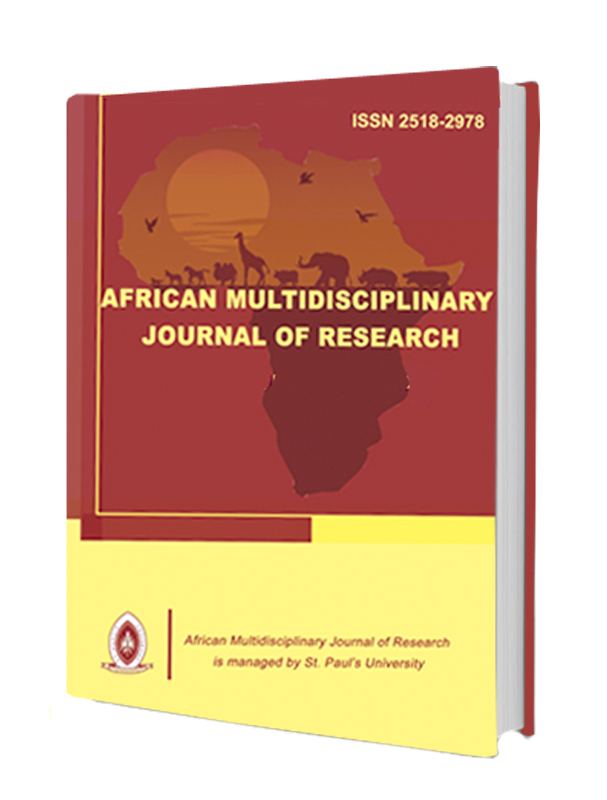Religion, Literature, Medicine and Music as Therapies of Depression and Mood Disorders in the United Republic of Tanzania: A Psycho-Ethical Reflection
##plugins.themes.academic_pro.article.main##
Abstract
This study focuses most especially on two age groups: i) children ages 8-18, and youth ages 18-28. The most common types of mood disorders among children and youth are major depression, dysthymia (dysthymic disorder), bipolar disorder, mood disorder due to a general medical condition, and substance-induced mood disorder. Dysthymia is a milder, but long-lasting form of depression. It is also called persistent depressive disorder. There is no clear cause of dysthymia disorder, but mental health professionals think it is a result of chemical imbalances in the brain. Some types of depression seem to run in families, but no genes have yet been linked to depression. There is no clear cause of mood disorders. Rapid changes in health care technology are advancing mental health care. Religion and medicine in the form of live interactive music has demonstrated its ability to improve access to high-quality mental health care, specifically in the therapy of patients with depression and mood disorders. The objectives of this study are four-fold: i) To review the advances in religion, literature, medicine, and music in the therapy of depression and mood disorders among children and youth. ii) to examine the evolving and innovative models of care, iii) to synthesize literature, music, poetry and lessons learned about mental health, and iv) to examine current and future pediatric and adolescent pragmatic implications for the treatment of depression and mood disorders in various clinical settings. Religion, literature, medicine and music have important and expanding roles in addressing the pediatric and adolescent mental health burdens of depression and mood disorders. Qualitative research methods are employed in this study. Theories used are Religious Therapy (RT), Literature Therapy Theory (LTT) Well-Being-Theories (WBT), Logotherapy (LT) and Music-Therapy Theory (MTT) in the context of gestalt integrated therapy. The American Psychiatric Association defines dysthymia as depressed mood most of the time for at least two years, along with at least two of the following symptoms: poor appetite or overeating; insomnia or excessive sleep; low energy or fatigue; low self-esteem; poor concentration or indecisiveness; and hopelessness. The study concludes that religion, literature, medicine and music hold promise on the treatment and therapy of depression and mood disorders.
##plugins.themes.academic_pro.article.details##
References
- Achebe, C. (1958). Things fall apart. London: Penguin Classics.
- American Psychiatric Association (APA). (2013). Diagnostic and statistical manual of mental disorders, American Psychiatric Association, Arlington, VA, USA, 5th edition, 2013.
- Armstrong, A. (2024). Healing thought the Vagus nerve: Improve your body’s response to anxiety, depression, stress and trauma through nervous system regulation. Kindle Edition.
- Atkinson, R. et al. (1993). Introduction to psychology. Eleventh Edition. Fort Worth, TX: Harcourt Brace College Publishers.
- Belgum, D. (ed.). (1967). Religion and medicine. Ames, Iowa: Iowa State University Press.
- Carlson N. et al. (2007). Psychology: The Science of Behavior. Sixth International Edition. Boston, MA: Pearson Education, Inc.
- Clark et al. (2020). “Holes in the wall: examining gaps in knowledge in child and adolescent mental health in Tanzania – scoping review”, In Tropical medicine & international health, a European Journal TMIH. Sustainable Development Goals SGDs 2. 3.3 and 3.4.
- Clayman, B. C. (1993). Genes and inheritance. Pleasantville: Reader’s Digest Association, Inc and the American Medical Association (AMA).
- Cosby, C. P. (2001). Methods in behavioral research. Ninth Edition. Boston, MA: McGraw Hill Company, Inc.
- Freud, A. (1935). Psychoanalysis for teachers and parents. Trans. Barbara Low. New York: W. W. Norton Company.
- Goudy, R. J. (2023). Guided pathways to healing: journaling past anxiety and depression. Independently Published.
- Hollander, E. et al. (2003). Concise guide to anxiety disorders. Washington, DC: American Psychiatric Publishing, Inc.
- Jenkins, R. et al. (2010). Common mental disorders and risk factors in Urban Tanzania. International Journal of Environmental Research and Public Health, vol. 7, no. 6, pp. 2543–2558, 2010.
- Moledina, et al. (2018). Prevalence and associated factors of depression in an Asian Community in Dar es Salaam, Tanzania. Psychiatry journal. Vol. 2018 | Article ID 9548471. Hindawi.
- Ridley, M. (1999). Genome: The autobiography of a species in 23 chapters. New York: HarperCollins Publishers.
- Santrock, W. J. (1997). Psychology. Boston, MA: McGraw Hill Company, Inc.
- Santrock, W. J. (2006). Educational psychology. Boston: McGraw Hill Company, Inc.
- Seligman, M. (2012). Flourish: A visionary new understanding of happiness and well-being. Aminjikarai, Chennai: Atria Books.
- Seligman, M. (2018). On mental thoughtfulness. Boston, MA: Harvard Business Review.
- Sobin, C., & Sackeim A. H. (1997). Psychomotor Symptoms of Depression. The American journal of psychiatry. American Psychological Association (APA) 154(1), 4–17.
- Strathern, P. (2005). A brief history of medicine: from hippocrates to gene therapy. London: Robinson.
- United Nations (UN). (2007). The millennium development goals report. United Nations: New York.
- Worchel, J. et al. (1983). Understanding social psychology. Homewood, IL: The Dorsey Press.

